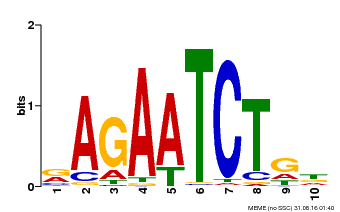 |
PlantRegMap/PlantTFDB v5.0
Plant Transcription
Factor Database
|
| Home TFext BLAST Prediction Download Help About Links PlantRegMap |
Transcription Factor Information
| Basic Information? help Back to Top | |||||||||
|---|---|---|---|---|---|---|---|---|---|
| TF ID | XP_013593048.1 | ||||||||
| Organism | |||||||||
| Taxonomic ID | |||||||||
| Taxonomic Lineage |
cellular organisms; Eukaryota; Viridiplantae; Streptophyta; Streptophytina; Embryophyta; Tracheophyta; Euphyllophyta; Spermatophyta; Magnoliophyta; Mesangiospermae; eudicotyledons; Gunneridae; Pentapetalae; rosids; malvids; Brassicales; Brassicaceae; Brassiceae; Brassica
|
||||||||
| Family | G2-like | ||||||||
| Protein Properties | Length: 428aa MW: 46889.7 Da PI: 7.5163 | ||||||||
| Description | G2-like family protein | ||||||||
| Gene Model |
|
||||||||
| Signature Domain? help Back to Top | |||||||
|---|---|---|---|---|---|---|---|
| No. | Domain | Score | E-value | Start | End | HMM Start | HMM End |
| 1 | G2-like | 89.1 | 4.1e-28 | 158 | 212 | 1 | 56 |
G2-like 1 kprlrWtpeLHerFveaveqLGGsekAtPktilelmkvkgLtlehvkSHLQkYRla 56
k +++WtpeLH+rFveaveqL G ekA+P++ilelm+v++Lt+++v+SHLQkYR++
XP_013593048.1 158 KRKVDWTPELHRRFVEAVEQL-GLEKAVPSRILELMGVHCLTRHNVASHLQKYRSH 212
5799*****************.********************************86 PP
| |||||||
| Protein Features ? help Back to Top | ||||||
|---|---|---|---|---|---|---|
| Database | Entry ID | E-value | Start | End | InterPro ID | Description |
| PROSITE profile | PS51294 | 18.069 | 155 | 214 | IPR017930 | Myb domain |
| Gene3D | G3DSA:1.10.10.60 | 3.6E-27 | 156 | 215 | IPR009057 | Homeodomain-like |
| SuperFamily | SSF46689 | 7.17E-18 | 158 | 215 | IPR009057 | Homeodomain-like |
| TIGRFAMs | TIGR01557 | 2.0E-26 | 158 | 212 | IPR006447 | Myb domain, plants |
| Pfam | PF00249 | 7.7E-8 | 161 | 210 | IPR001005 | SANT/Myb domain |
| Gene Ontology ? help Back to Top | ||||||
|---|---|---|---|---|---|---|
| GO Term | GO Category | GO Description | ||||
| GO:0007165 | Biological Process | signal transduction | ||||
| GO:0009658 | Biological Process | chloroplast organization | ||||
| GO:0009910 | Biological Process | negative regulation of flower development | ||||
| GO:0010380 | Biological Process | regulation of chlorophyll biosynthetic process | ||||
| GO:0045893 | Biological Process | positive regulation of transcription, DNA-templated | ||||
| GO:1900056 | Biological Process | negative regulation of leaf senescence | ||||
| GO:0003700 | Molecular Function | transcription factor activity, sequence-specific DNA binding | ||||
| GO:0044212 | Molecular Function | transcription regulatory region DNA binding | ||||
| Sequence ? help Back to Top |
|---|
| Protein Sequence Length: 428 aa Download sequence Send to blast |
MLALSPARNS TRDDGESEFR ATSCGFSINP EEDFPEFAVH GDLLDIIDFD DLFGVAGDVL 60 PDLEMDPEIL GGELSDHMNA SSTITTTTSS SEKTKSQGKS NNKKGIPGKG EEVVSKRDHN 120 ETPVAETVVN YDGDSGRKRS HSSSGSTKRN PISNNEGKRK VDWTPELHRR FVEAVEQLGL 180 EKAVPSRILE LMGVHCLTRH NVASHLQKYR SHRKHLLARE AEAANWTRKR HIYGLDSTGA 240 NANGRNRNGW LAPAPTLGYP PPPPAAVASP PVHHHHLRPL HVWGHPTVDQ SVMQHVWPKH 300 LPPPSTAMAT PPFWVSHTPY WPRIHNGTTP FLPTVATRFR TPPVAGIPQA LPSHHMVYNY 360 KPDHGFGGPR SLVDLHPSKE SVDAAIGDVL TRPWLPLPLG LKPPAVDGVI TELHRHGVSD 420 VPPAASCA |
| 3D Structure ? help Back to Top | ||||||
|---|---|---|---|---|---|---|
| PDB ID | Evalue | Query Start | Query End | Hit Start | Hit End | Description |
| 5lxu_A | 7e-15 | 163 | 214 | 6 | 57 | Transcription factor LUX |
| Search in ModeBase | ||||||
| Expression -- UniGene ? help Back to Top | ||||||
|---|---|---|---|---|---|---|
| UniGene ID | E-value | Expressed in | ||||
| Bol.4793 | 1e-136 | leaf | ||||
| Expression -- Description ? help Back to Top | ||||||
|---|---|---|---|---|---|---|
| Source | Description | |||||
| Uniprot | TISSUE SPECIFICITY: Expressed in rosette and cauline leaves. Expressed at low levels in cotyledons and shoots. {ECO:0000269|PubMed:12220263}. | |||||
| Functional Description ? help Back to Top | ||||||
|---|---|---|---|---|---|---|
| Source | Description | |||||
| UniProt | Transcriptional activator that functions with GLK2 to promote chloroplast development. Acts as an activator of nuclear photosynthetic genes involved in chlorophyll biosynthesis, light harvesting, and electron transport. Acts in a cell-autonomous manner to coordinate and maintain the photosynthetic apparatus within individual cells. May function in photosynthetic capacity optimization by integrating responses to variable environmental and endogenous cues (PubMed:11828027, PubMed:12220263, PubMed:17533111, PubMed:18643989, PubMed:19376934, PubMed:19383092, PubMed:19726569). Prevents premature senescence (PubMed:23459204). {ECO:0000269|PubMed:11828027, ECO:0000269|PubMed:12220263, ECO:0000269|PubMed:17533111, ECO:0000269|PubMed:18643989, ECO:0000269|PubMed:19376934, ECO:0000269|PubMed:19383092, ECO:0000269|PubMed:19726569, ECO:0000269|PubMed:23459204}. | |||||
| Binding Motif ? help Back to Top | |||
|---|---|---|---|
| Motif ID | Method | Source | Motif file |
| MP00022 | PBM | Transfer from AT2G20570 | Download |

| |||
| Cis-element ? help Back to Top | |
|---|---|
| Source | Link |
| PlantRegMap | XP_013593048.1 |
| Regulation -- Description ? help Back to Top | ||||||
|---|---|---|---|---|---|---|
| Source | Description | |||||
| UniProt | INDUCTION: By light. Repressed by BZR2. {ECO:0000269|PubMed:12220263, ECO:0000269|PubMed:21214652}. | |||||
| Regulation -- PlantRegMap ? help Back to Top | ||||||
|---|---|---|---|---|---|---|
| Source | Upstream Regulator | Target Gene | ||||
| PlantRegMap | Retrieve | Retrieve | ||||
| Annotation -- Protein ? help Back to Top | |||||||
|---|---|---|---|---|---|---|---|
| Source | Hit ID | E-value | Description | ||||
| Refseq | XP_013593048.1 | 0.0 | PREDICTED: transcription activator GLK1 isoform X4 | ||||
| Swissprot | Q9SIV3 | 0.0 | GLK1_ARATH; Transcription activator GLK1 | ||||
| TrEMBL | A0A0D3D284 | 0.0 | A0A0D3D284_BRAOL; Uncharacterized protein | ||||
| STRING | Bo7g003410.1 | 0.0 | (Brassica oleracea) | ||||
| Best hit in Arabidopsis thaliana ? help Back to Top | ||||||
|---|---|---|---|---|---|---|
| Hit ID | E-value | Description | ||||
| AT2G20570.1 | 1e-164 | GBF's pro-rich region-interacting factor 1 | ||||



